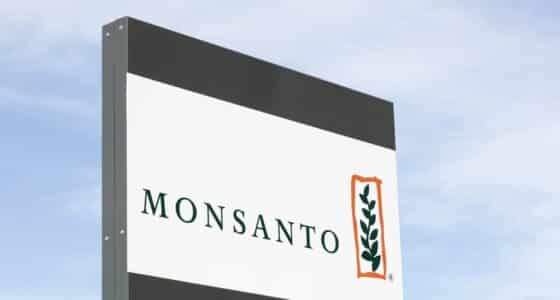Monsanto is a chemical company that’s been named as a defendant in many toxic injury lawsuits. It never manufactured products that contained asbestos, but the company made extensive use of the carcinogenic material in its plants to insulate high-heat operations and in other applications. When these materials became worn or damaged, they released deadly fibers into the air, exposing workers to the risk of mesothelioma and other serious illnesses. Many of these employees’ family members were also sickened through secondary exposure from asbestos carried home on workers’ clothing.

The History of Monsanto
Monsanto had its start in 1901, when John F. Queeny started the Monsanto Chemical Works in St. Louis, Missouri. Queeny invested $1,500 of his own money and borrowed another $3,500 from a local Epsom salts manufacturer to launch his new company, which he named to honor his wife’s maiden name. The firm initially focused on producing saccharin, a synthetic sweetener, which was then only manufactured in Germany. The business grew rapidly, reaching full-scale saccharin production by 1902 and turning a profit by 1905.[1]
Over the next few years, the company’s product line expanded to include caffeine and vanillin. The Coca-Cola Company became one of Monsanto’s chief customers, and the company’s sales had reached $1 million by 1915. The company began producing aspirin in 1917.
As was true of so many other American companies, Monsanto expanded during World War I and flourished under the protection of high U.S. tariffs in the 1920s. In 1928, John Queeny passed control of the company to his son, Edgar M. Queeny, and before he retired from the company himself, Edgar transformed Monsanto into an industrial giant. It was incorporated as the Monsanto Chemical Company in 1933. Its production of styrene, a component of synthetic rubber, was vital to the World War II war effort.
As a result of its rapidly diversifying product line, the company changed its name to Monsanto Company in 1964. Throughout the latter half of the 20th century, Monsanto expanded through a series of strategic acquisitions. In 1985, the company purchased pharmaceutical firm G.D. Searle & Co., maker of the NutraSweet artificial sweetener, and in the 1990s, its acquisition of biotechnology firms made it a leader in the development and production of genetically modified crop seeds.
In 1997, Monsanto rebranded itself as a “life sciences” company. It created a new company for its chemical division called Solutia Inc., and merged with global pharmaceutical company Pharmacia & Upjohn in 2000, but in August 2002, Monsanto’s non-pharmaceutical segments were spun off, and the company became a publicly traded entity focused on agriculture and biotechnology.
As the public increasingly opposed genetically modified organisms and the company began being sued by people claiming exposure to its chemicals had caused serious health issues, it was purchased by Bayer, a German chemical and pharmaceutical company, in 2016. The deal was valued at more than $60 billion and finalized in 2018.
Monsanto became part of Bayer’s crop science division and operated numerous chemical manufacturing facilities across the United States. Almost all of these industrial operations required significant heat for their manufacturing processes, and as a result, the buildings and equipment contained significant amounts of asbestos insulation.
How Monsanto Used Asbestos
As a chemical manufacturer, Monsanto did not manufacture or distribute any asbestos-containing products, but the company had dozens of manufacturing plants and facilities that made extensive use of asbestos-containing materials manufactured by other companies. In August 1972, a senior buyer at Monsanto confirmed the significant presence of asbestos in the company’s plants, citing a study that estimated approximately 60% of all insulation used in the plants contained asbestos.[2]
Because the mineral’s exceptional durability, heat resistance, and fireproofing qualities made it ideal for protecting against the high temperatures required by Monsanto’s chemical manufacturing operations, asbestos materials were found throughout plants across the country.
Monsanto Facilities with Known Asbestos Use
The Monsanto facilities with documented asbestos use were located in the following cities:
- Alvin, Texas (Chocolate Bayou Plant)
- Anniston, Alabama
- El Dorado, Arkansas
- Fayetteville, North Carolina
- Greenwood, South Carolina
- Monroe, Washington
- Sauget, Illinois (W.R. Krummrich Plant)
- Springfield, Massachusetts
- St. Louis, Missouri (John F. Queeny Plant)
- Texas City, Texas
In a legal document from 2000, Monsanto admitted to the presence of asbestos in and around its Texas facilities. The asbestos materials present on the grounds included:
Building Materials:
- Floor tiles
- Roofing materials
- Siding
- Transit board
Industrial Equipment:
- Pipe insulation
- Vessel insulation
- Boiler insulation
Operational Components:
- Gaskets
- Packing materials
Monsanto relied on asbestos-containing products at its Texas facilities up until 1972. In court proceedings, the company further admitted that asbestos gaskets may have continued to be used beyond that year until suitable substitute materials became available.
The widespread use of asbestos in Monsanto’s facilities was driven by the chemical industry’s need for materials that could withstand extreme heat while providing fire protection and insulation for workers and equipment.
Who Was Exposed to Asbestos at Monsanto?
Workers at Monsanto facilities around the country faced significant occupational exposure through their daily activities and job responsibilities, but the risk extended beyond those who directly handled asbestos materials. Asbestos particles released into the air by asbestos-contaminated materials being manipulated, damaged, or deteriorating circulated throughout the facilities, putting everybody in the environment in danger.
Monsanto Employees at Particular Risk
- Maintenance workers who regularly worked with asbestos-containing gaskets and pipe insulation used to maintain production line equipment
- Boiler repairmen who serviced heating systems lined with asbestos insulation
- Chemical plant workers operating in facilities where asbestos materials were present in walls, ductwork, and equipment
- Construction workers and carpenters involved in building maintenance and renovations.
- Electricians and electrical engineers working with electrical equipment containing asbestos components
- HVAC workers who maintained heating and ventilation systems
- Pipefitters and plumbers who worked with asbestos-insulated pipes
- Welders and steamfitters working near asbestos-containing materials
- Ironworkers and machinists working with equipment that contained asbestos components
- Quality assurance workers and systems operators who worked throughout the facilities
- Administrative staff and secretaries who worked in buildings with asbestos-containing materials
- Navy veterans who may have worked at Monsanto facilities
Activities That Released Asbestos Fibers
Monsanto employees were exposed to asbestos when invisible particles of the fibrous material became airborne during routine maintenance and operations. Common exposure scenarios included:
- Cutting into insulation or other asbestos-containing materials during repairs
- Removing worn gaskets and packing materials from pumps and machinery
- Maintaining or repairing boilers and ovens with asbestos insulation
- Working in areas where asbestos-containing building materials had deteriorated
- Handling protective equipment and clothing that contained asbestos
Secondary Asbestos Exposure
Family members of Monsanto workers also faced health risks through secondary exposure. When plant employees returned home from work each day, they weren’t aware that they frequently carried asbestos fibers home on their clothing, shoes, skin, and hair. This material then contaminated family vehicles, furniture and carpeting within their homes, and had the effect of exposing spouses, children, and other household members to the dangerous mineral. This type of take-home exposure has had tragic effects for spouses who laundered workers’ contaminated work clothes, and even for children who sat on their fathers’ laps or hugged them when they returned home from work each day.
Health Consequences of Asbestos Exposure
People who were exposed to asbestos at Monsanto facilities were put at risk of developing serious health conditions. Many of these illnesses don’t show symptoms until decades after exposure. The latency period for asbestos-related diseases can range from 20 to 50 years, which means that workers and their family members who were exposed through the 1970s or later may only now begin experiencing symptoms.
Asbestos-related diseases include:
Pleural Mesothelioma: A rare, aggressive cancer affecting the organ that lines the cavity that holds the lungs.
Peritoneal Mesothelioma: A rare, aggressive cancer affecting the organ that lines the cavity that holds the abdominal organs.
Pericardial Mesothelioma: One of the rarest forms of mesothelioma, pericardial mesothelioma affects the lining of the cavity that holds the heart.
Lung Cancer: Malignant tumors that develop in the lungs, often decades after exposure. The risk of both asbestos-related lung cancer and mesothelioma is heightened in those who were both exposed to asbestos and who smoked cigarettes.
Asbestosis: A chronic disease in which progressive scarring of the lung tissue causes breathing difficulties and respiratory problems.
Pleural Plaques: Thickened areas of the lung lining that can indicate asbestos exposure.
Other Cancers: Including colon, throat, and gastrointestinal cancers linked to asbestos exposure.
Mesothelioma and Asbestos Lawsuits Filed Against Monsanto
Monsanto has faced many legal challenges from workers who developed mesothelioma and other asbestos-related illnesses after exposure at company facilities. These lawsuits have resulted in compensation awards and significant settlements for victims.
Notable Legal Cases
Many Monsanto workers who were exposed to asbestos on the job and later developed mesothelioma, lung cancer, or other related illnesses filed lawsuits against the company. Some received settlements, while others successfully filed lawsuits that named Monsanto among the defendants.
One example can be found in a case filed by the surviving spouse and adult children of Namon Joshua, Jr., a carpenter who died of lung cancer. Mr. Joshua’s family sued the owners of various work sites where Mr. Joshua had been employed, asserting that his fatal illness was caused by occupational exposure to asbestos while working on their premises. The jury awarded $2 million in survival damages, $2.75 million in wrongful death damages to the victim’s surviving spouse, $200,000 to one of his surviving children, and $250,000 each to four other surviving children. Monsanto’s Chemical Plant was one of the defendants in this case, and the jury assigned it 10% responsibility for the award.[3]
After Monsanto spun off its chemical business into Solutia Inc. in 1997, the new company faced substantial asbestos litigation. Over six years, Solutia faced over 570 lawsuits related to asbestos and spent over $100 million per year defending them, including two settlements worth over $3 million.
By 2008, Monsanto agreed to take financial responsibility for lawsuits related to events before the creation of Solutia Inc. These lawsuits involved property damage, injuries, and product liability tied to asbestos and various toxic chemicals.[4]
Have You Been Diagnosed with Mesothelioma After Asbestos Exposure at a Monsanto Site?
If you worked at a Monsanto facility and either you or one of your family members has been diagnosed with mesothelioma or another asbestos-related disease, you may be eligible to take legal action against the company. Victims of asbestos exposure have several legal options available to them, including:
Filing Personal Injury and Wrongful Death Lawsuits
Victims of asbestos exposure may be eligible to file lawsuits against Monsanto and other responsible parties to recover damages for medical expenses, lost wages, pain and suffering, and other losses.
Workers’ Compensation Claims
Former Monsanto employees may be eligible for workers’ compensation benefits for occupational asbestos exposure leading to diagnosis with an asbestos-related injury.
Third-Party Claims
If you’ve been diagnosed with an asbestos-related disease after having been exposed to asbestos at a Monsanto facility, you may be eligible to file a claim against the companies that supplied asbestos-containing products to the site where you worked. This may include manufacturers of asbestos-containing insulation, gaskets, and other materials.
What to Do if You Were Exposed
If you worked at a Monsanto facility and have been diagnosed with mesothelioma, lung cancer, or another asbestos-related illness, or if you are a family member whose secondary exposure to asbestos from the site has led to a diagnosis, your priority is establishing and beginning a treatment plan. But after your health needs have been addressed, your family’s financial security and your ability to pay for your medical bills should be high on your list. To address these important issues, take the following steps as soon as possible:
- Consult with an experienced mesothelioma attorney. These lawyers specialize in asbestos claims and have extensive resources that will make a real difference in the success of your legal journey.
- Gather documentation of your work history and any potential exposure to asbestos throughout your life.
- Collect all medical records about your diagnosis.
- Act quickly, as each state has its own statute of limitations that limits the amount of time you have between getting a confirmed diagnosis and taking legal action.
Asbestos litigation is complex, and the companies that exposed you to asbestos have teams of attorneys working on their behalf. To make sure your rights are protected and you receive the maximum compensation for the harms you’ve suffered, it’s important to work with an experienced asbestos lawyer who has the tools and knowledge for this specific type of legal claim.
References
- Britannica Money. (N.D.). Monsanto.
Retrieved from: https://www.britannica.com/money/Monsanto - Toxic Docs. (N.D.). Monsanto.
Retrieved from: https://cdn.toxicdocs.org/93/93Jgk4yQLDbo768Yp39bkKBKR/93Jgk4yQLDbo768Yp39bkKBKR.pdf - Google Scholar. (N.D.). Thomas v. AP Green Industries, Inc., 933 So. 2d 843 – La: Court of Appeals, 4th Circuit 2006
Retrieved from: https://scholar.google.com/scholar_case?case=18329896919496597724&hl=en&as_sdt=6&as_vis=1&oi=scholarr - Floor Daily. (N.D.). Monsanto to Set Aside $285 Million for Solutia.
Retrieved from: https://www.floordaily.net/flooring-news/monsanto-to-set-aside-285m-for-solutia

Terri Heimann Oppenheimer
WriterTerri Oppenheimer has been writing about mesothelioma and asbestos topics for over ten years. She has a degree in English from the College of William and Mary. Terri’s experience as the head writer of our Mesothelioma.net news blog gives her a wealth of knowledge which she brings to all Mesothelioma.net articles she authors.

Dave Foster
Page EditorDave has been a mesothelioma Patient Advocate for over 10 years. He consistently attends all major national and international mesothelioma meetings. In doing so, he is able to stay on top of the latest treatments, clinical trials, and research results. He also personally meets with mesothelioma patients and their families and connects them with the best medical specialists and legal representatives available.


